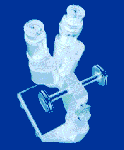
Consulting Entomologist

Tel/Fax: 01275 854224
E-Mail: [email protected]
Site Guide
Site Search
Home Page
Career Page
Insect Files
- Contents
- Bug Index
- The World of Bugs
- Classification of Bugs
- Insect Identification
- Insect Fossils
- Insect Body-parts
- Micro View of Bugs
- Insect Life Cycles
- Insect Defences
- Insects of Nailsea
- Pesticide Safety
- Bibliography
Shortcut to the main groups of insects and other arthropods...
Bug Rhymes & Poems
Links
Shop
Payments (credit/debit card)
Insect Body-partsA brief guide to the main external features of insects and the terminology used to describe the various body-parts. |
|
| ||
|
The insect body is divided into three main parts - head, thorax and abdomen - as shown above. Head. The head bears the mouthparts, the eyes and a pair of antennae (singular: antenna). Most adult insects and the immature stages (nymphs) of Exopterygota have a pair of large, multi-faceted compound eyes (labelled 'eye' in the diagram above). Many of these insects also have two or more small, single-faceted eyes, called simple eyes or ocelli (singular: ocellus), usually placed on the top or front of the head between the compound eyes. In some insects, particularly those belonging to the Apterygota, and in the immature stages (larvae) of all Endopterygota, compound eyes are lacking and only ocelli are present, with one or more of these simple eyes on each side of the head. In a few adult insects and among many larval forms, eyes are completely absent. Thorax. The thorax consists of three segments - the prothorax (front), the mesothorax (middle) and the metathorax (back). Each of these segments bears a pair of jointed legs. Each leg consists of four main parts - the coxa, the femur, the tibia and the tarsus (plural: tarsi) - with a small, often inconspicuous segment between the coxa and femur, called the trochanter. The tarsus usually consists of several small joints, the last of which generally carries a pair of terminal claws. The last tarsal segment may be extended between the claws to form a pad-like organ - the arolium (as in (1) below). Some Diptera (true flies) have two additional pads - the pulvilli (singular: pulvillus) - lying below the claws on either side of the arolium (as in (2) below), although in most flies, including the common housefly and its relatives, the arolium is replaced by a stout central bristle - the empodium (as in (3) below). In many insects, the other tarsal segments also have ventral pulvillus-like organs, called plantulae. These various structures - the arolium, pulvilli and plantulae - produce a sticky secretion and act like 'suction-pads', enabling the insect to climb smooth or steep surfaces. This is the secret of the fly's ability to walk up-side-down on the ceiling! | ||
| Terminal Segments of the Tarsus (see text above for details) | ||
(1) |
(2) |
(3) |
| (a = arolium, c = claw, e = empodium, p = pulvillus) | ||
|
In winged insects, the meso- and metathoracic segments each bear a pair of wings (the forewings and hindwings, respectively), although in many insects one or both pairs of wings have been lost, or modified into other structures, during the course of evolution. Special wing modifications include the structures called halteres found in the Diptera (true flies), and the structures called elytra (singular: elytron) found in the Coleoptera (beetles) and Dermaptera (earwigs): | ||
Halteres - small, club-shaped organs of balance found in Diptera (flies) on each side of the thorax (metathorax) just behind the forewings and thought to be modified vestigial hindwings. | |
Elytra (singular: elytron) - the hard, leathery forewings of Coleoptera (beetles) and Dermaptera (earwigs), that serve as protective coverings or 'wing-cases' for the membranous hindwings. The hindwings (if present) are usually folded out of sight under the elytra when at rest. The diagram shows a green tiger beetle (Cicindella campestris) with the elytra open and hindwings outstretched, as the beetle appears when in flight. |
|
Abdomen. The abdomen is made up of several, more or less similar segments and often bears a pair of jointed, terminal appendages called the cerci (singular: cercus). Typical cerci are illustrated in (a) below, although in some insects they consist of many more joints than in the example shown. |
| Abdominal Appendages of Adult Insects | |||
|
|
|
|
|
| (a) typical cerci |
(b) cerci and tail filament |
(c) cerci modified as forceps e.g. earwigs |
(d) paired cornicles e.g. some aphids |
| <<< TOP | (use the back button on your web browser to return to the previous page) | TOP >>> |
